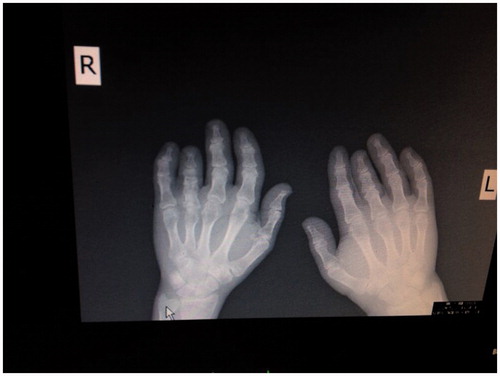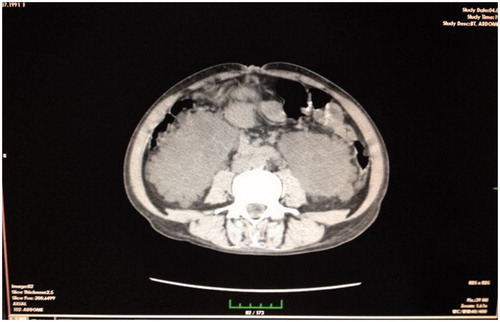Abstract
Orofacial digital syndrome type 1 is condition which is characterized with, in addition to oral-facial and digital congenital anomalies, polycystic renal disease in most patient, and the prognosis is dependent on renal involvement in such patients. Our case was a 22-year-old patient who was presented with clinical picture of chronic renal failure, was started on hemodialysis and had took our attention due to oral, facial and digital anomalies in addition to polycystic renal disease.
Case report
A 22-year-old female was admitted to a healthcare facility due to complaints of swelling in hands and feet for 1 year, and the patient was referred to our clinic, since creatinine level was 8.3. On admission, blood pressure was 140/80 mmHg, and skin and conjunctivas were severely pale; there was malocclusion of teeth, while micrognathism, cleft tongue, solid lesion palpable at right side of abdomen, brachydactyly in bilateral fingers () and toes and pretibial edema (++/++) were noted. On psychiatric examination, moderate mental retardation was present. Other systemic examinations were normal. Personal history indicated excision of nodule on tongue. There was no familial history of renal disease. Laboratory tests were as follows: Creatinine was 8.3 mg/dL, Ca level was low, while P and K levels were high. Proteinuria (+) was found, while Hb was 3.9 g/dL. On abdominal ultrasonography, size of bilateral kidneys increased, while widespread cysts were present. Cortex could not be visualized. On non-contrast mediated abdominal CT, renal dimensions increased (15 and 16 cm), while multiple cysts were present in bilateral kidneys (). Hepatic cyst was not observed. Echocardiography was studied. Ejection fraction was 60%, while there was mitral failure (2/4); left ventricular hypertrophy and left ventricular diastolic dysfunction were noted. Pulmonary arterial pressure was 25 mmHg. Cranial MRI angiography was normal. On cranial MRI, small lacunas were found in bilateral corona radiate, periventricular area and subcortical area of right frontal cortex, while gliosis was present in right frontal white matter and minimal frontal cortical atrophy was observed. Chronic renal failure was considered for the patient, while patient was included in chronic dialysis program following arteriovenous fistulation.
Discussion
Orofacial-digital syndrome type 1 is characterized with, in addition to anomalies of oral cavity, face and fingers and toes, polycystic renal disease in 60% of patients.Citation1,Citation2 It can be differentiated from other 9 types of orofacial digital syndrome, based on presence of polycystic renal disease.Citation3 It is hard to distinguish from other cystic diseases of kidney using imaging studies. In comparison with autosomal dominant polycystic renal disease (ADPRD), cysts were smaller and more uniform. On ADPRD, cysts are comprised of tubules; however, they develop in both tubules and glomerules in OFD. Such patients may develop hepatic and pancreatic cysts, similar to ADPRD, but absence of such cysts does not rule out the diagnosis.Citation4 Our patient did not have hepatic cyst, although she had polycystic renal disease. In ADPRD, familial history is not found only in 25% of patients, while familial history is found only in 25% of patients in Type 1 OFD. Diagnosis of chronic renal failure is not common in ADPRD before age of 40 years; however, in Type 1 OFD, diagnosis is usually made based on renal findings after age of 18 years.Citation5 Oral findings of malposition of teeth, cleft tongue and history of nodule excision on tongue were related with OFD syndrome Type 1. Facial finding was micrognathism, while brachydactyly was found in both fingers and toes.Citation6 On psychiatric examination, there was mild decrease in intellectual capacity. Orofacial and digital findings were other characteristics, which were used to differentiate from ADPRD.
In conclusion, in differential diagnosis of renal failure secondary to cystic renal disease, orofacial digital syndrome type 1 should be considered, although it is rare, if chronic renal failure occurred at young age.
Declaration of interest
The authors declare no conflicts of interests. The authors alone are responsible for the content and writing of this article.
References
- Dodge JA, Kernohan DC. Oral-facial-digital syndrome. Arch Dis Child. 1967;42:214–219
- Saal S, Faivre L, Aral B. Renal insufficiency, a frequent complication with age in oral-facial-digital syndrome type I. Clin Genet. 2009;77:258–265
- GeneReviews™. Available at: http://www.ncbi.nlm.nih.gov/books/NBK1188. Initial Posting: July 24, 2002. Last Accessed February 28, 2013
- Scolari F, Valzorio B, Carli O, et al. Oral-facial-digital syndrome type I: an unusual cause of hereditary cystic kidney disease. Nephrol Dial Transplant. 1997;12:1247–1250
- Prattichizzo C, Macca M, Novelli V, Giorgio G, Barra A, Franco B. Mutational spectrum of the oral-facial-digital type I syndrome: a study on a large collection of patients. Hum Mutat. 2008;29:1237–1246
- Mihci E, Tacoy S, Ozbilim G, Franco B. Oral-facial digital syndrome type 1. Indian Pediatr. 2007;44:854–856


